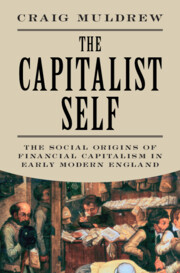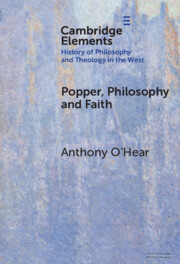Refine search
Actions for selected content:
176 results
Chapter 3 - Transcending Lyrical Love’s Joy in the Italian Trecento
-
- Book:
- The Joy of Love in the Middle Ages
- Published online:
- 20 November 2025
- Print publication:
- 04 December 2025, pp 68-101
-
- Chapter
- Export citation
Boyle’s Elusive Egoism
-
- Journal:
- Canadian Journal of Philosophy , FirstView
- Published online by Cambridge University Press:
- 27 November 2025, pp. 1-12
-
- Article
-
- You have access
- Open access
- HTML
- Export citation
5 - An Ethical Fulcrum: From Participation in the Body of Christ to the Happy Self
-
- Book:
- The Capitalist Self
- Published online:
- 12 October 2025
- Print publication:
- 30 October 2025, pp 197-225
-
- Chapter
- Export citation
Chapter 13 - Kantian Strains in Stages on Life’s Way
- from Part III - Kierkegaard and the Concept of Thought Experiment
-
- Book:
- Kierkegaard and the Structure of Imagination
- Published online:
- 26 September 2025
- Print publication:
- 16 October 2025, pp 214-229
-
- Chapter
- Export citation

The Capitalist Self
- The Social Origins of Financial Capitalism in Early Modern England
-
- Published online:
- 12 October 2025
- Print publication:
- 30 October 2025
Chapter 26 - Neural Evidence for Cultural Variation in Emotion
- from Section VI - Social Emotions
-
-
- Book:
- The Cambridge Handbook of Human Affective Neuroscience
- Published online:
- 16 September 2025
- Print publication:
- 02 October 2025, pp 523-543
-
- Chapter
- Export citation
10 - Social Transformations during Infancy
- from Part III - Lifespan Development in Diverse Sociocultural Contexts
-
-
- Book:
- The Cambridge Handbook of Psychological Anthropology
- Published online:
- 22 October 2025
- Print publication:
- 25 September 2025, pp 253-274
-
- Chapter
- Export citation
21 - Self and Experience
- from Part IV - Body, Emotion, Self, and Experience
-
-
- Book:
- The Cambridge Handbook of Psychological Anthropology
- Published online:
- 22 October 2025
- Print publication:
- 25 September 2025, pp 505-528
-
- Chapter
- Export citation
What Kinds of Practice are Necessary for Self-Consciousness?
-
- Journal:
- Canadian Journal of Philosophy , FirstView
- Published online by Cambridge University Press:
- 11 September 2025, pp. 1-10
-
- Article
-
- You have access
- Open access
- HTML
- Export citation
Chapter 4 - Opposites in the Cosmology of Magna Graecia
-
- Book:
- Aggregation and Antithesis in Ancient Greece
- Published online:
- 21 October 2025
- Print publication:
- 28 August 2025, pp 63-113
-
- Chapter
- Export citation
Chapter 1 - Staging Consent
-
- Book:
- Manufacturing Dissent
- Published online:
- 03 October 2025
- Print publication:
- 21 August 2025, pp 16-57
-
- Chapter
- Export citation
Chapter 7 - The Texture of Time
-
- Book:
- Healing and the Invention of Metaphor
- Published online:
- 17 July 2025
- Print publication:
- 31 July 2025, pp 175-200
-
- Chapter
- Export citation
Chapter 5 - Healing Fictions: Narrative Transformations of the Self
-
- Book:
- Healing and the Invention of Metaphor
- Published online:
- 17 July 2025
- Print publication:
- 31 July 2025, pp 116-145
-
- Chapter
- Export citation
Chapter 5 - Body, Mind, Soul, and Self
-
-
- Book:
- The Cambridge Companion to Marcus Aurelius' <i>Meditations</i>
- Published online:
- 02 July 2025
- Print publication:
- 17 July 2025, pp 82-108
-
- Chapter
- Export citation
7 - The Inflexible Self and Lived Time
- from Part II - Contemporary Approaches to Traditional Conceptual Perspectives
-
-
- Book:
- Conceptualizing Personality Disorder
- Published online:
- 25 June 2025
- Print publication:
- 10 July 2025, pp 130-146
-
- Chapter
- Export citation
Chapter 5 - Toddlerhood
- from Part I - The Beginnings of Meaning
-
- Book:
- The Development and Organization of Meaning
- Published online:
- 11 June 2025
- Print publication:
- 26 June 2025, pp 50-64
-
- Chapter
- Export citation
Chapter 13 - Trauma and Meaning
- from Part IV - Meaning and Disturbance
-
- Book:
- The Development and Organization of Meaning
- Published online:
- 11 June 2025
- Print publication:
- 26 June 2025, pp 175-184
-
- Chapter
- Export citation

Popper, Philosophy and Faith
-
- Published online:
- 23 May 2025
- Print publication:
- 12 June 2025
-
- Element
- Export citation
Geographies of Self and Other: Mapping Japan through the Koseki
-
- Journal:
- Asia-Pacific Journal / Volume 9 / Issue 29 / July 2011
- Published online by Cambridge University Press:
- 07 May 2025, e2
-
- Article
-
- You have access
- Open access
- Export citation
Chapter 16 - Byron and Shelley
- from Part II - Intellectual, Cultural, and Political Contexts
-
-
- Book:
- Percy Shelley in Context
- Published online:
- 17 April 2025
- Print publication:
- 24 April 2025, pp 121-127
-
- Chapter
- Export citation
